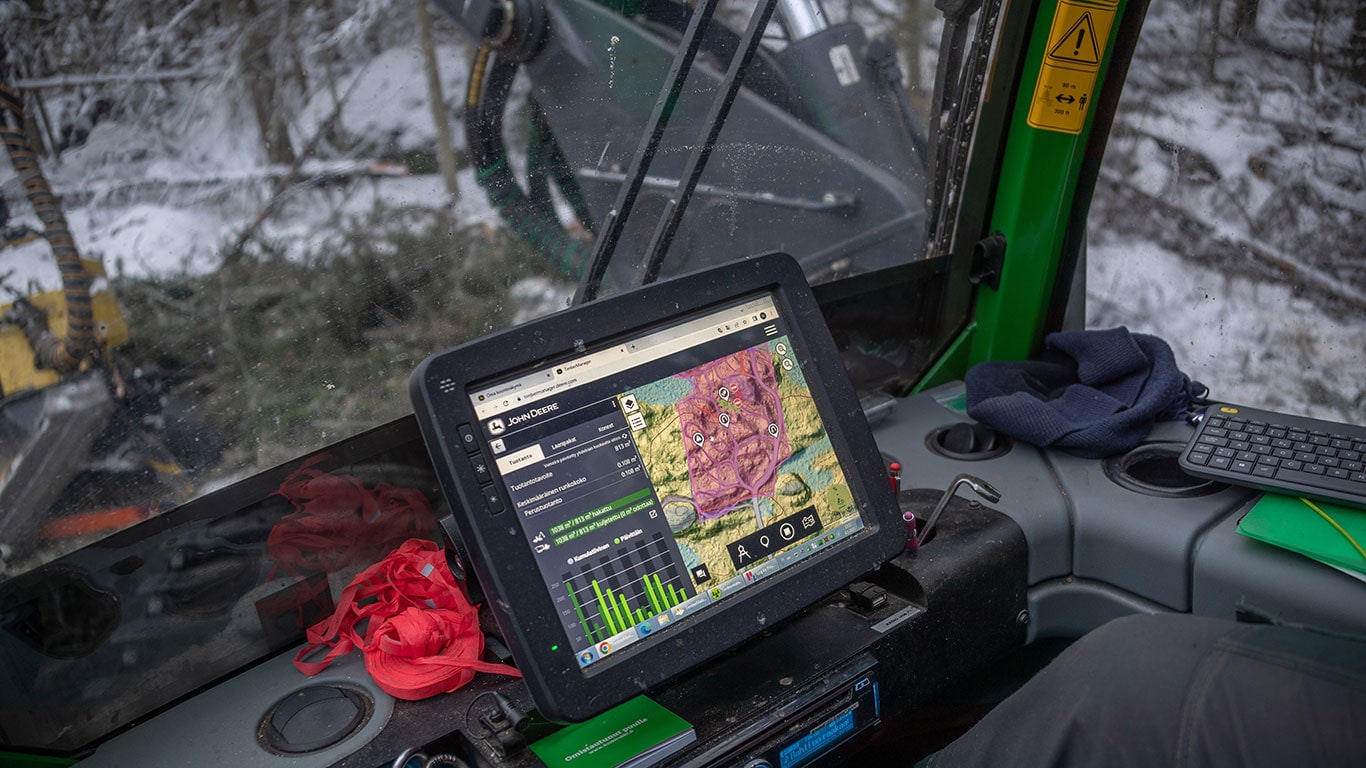
When forest machine contractor Riku Naarajärvi heard about the TimberMatic Maps application, he had already become accustomed to digital maps. Forest company map systems had long been in use, mainly in defining a logging area and work instructions, so he didn't have high expectations for the new application.
"It used to be that you didn't need a map to fell and transport trees," Naarajärvi remembers thinking. Nevertheless, he decided to give the new applications a chance. "Curiosity enticed me to take a closer look at the matter, and then I understood that it goes beyond just a map and work instructions, it's about management of the whole production chain. These have been designed with the contractor's real needs in mind."
Immediate benefits from the ease of use
The first harvester of the Längelmäki-based Pekka Naarajärvi company was the legendary Lokomo 990. Today the machine chain has three John Deere forwarders and the 1270G harvester, acquired in 2021, and the TimberMatic Maps and TimberManager applications that came with it. The ease of use of the maps and the benefits they bring to the day-to-day work were immediately clear. "The application automatically marks the location and species of the felled logs for the forwarder operator, making the work planning more efficient. There's no more guessing, and finding the logs is easy in the dark or in the snow," Riku Naarajärvi says.
The possibility to add different markings to the map, like retention trees, soft terrain areas and notes about the tracks also received praise. And the fact that TimberManager made the site planning even more precise with driving routes, landing areas, and estimates of different timber species quickly convinced Riku Naarajärvi about the usefulness of the application. But that was just the beginning.

Advanced map layers unlocked new possibilities
Introduced to Finnish customers in autumn 2022, the advanced map layers brought a lot of new features for contractors and operators: notifications of forest use, terrain map with oblique view, drivability maps highlighting moist terrain and steep slopes, visibility map, thinning removal, tree length, and landing suitability map.
"The advanced map layers unlocked the possibility to use data in a totally new way," Riku Naarajärvi says, and adds: "I thought, 'Why haven't these been available earlier?'"
"I thought, 'Why haven't these been available earlier?'
- Riku Naarajärvi -
Preplanning a logging site is really easy. The basic data about the site is easy to copy from forest company maps, and the actual logging site-specific planning is done using the detailed data provided by the new map layers in the TimberManager application. "For example, driving routes can be planned based on the terrain map with the oblique view and the drivability map. They show the terrain contours, like big boulders, steep slopes and ditches with surprising accuracy. The reality in the forest can sometimes differ, so the machine operator's visual assessment is still needed, but the map layers are at least indicative.
The features of the map layers are used in preplanning prior at the work site and in real time as the work progresses." According to Naarajärvi there is already an advantage by having familiarity with the site already during the planning phase and then learning more as the work progresses.
"For example, marking a retention tree can be done already when visiting the site and walking in the forest. When you place a mark on the map in the forest, the data is immediately visible to everyone working at the same logging site. There's no need to guess what this or that means. It's also easy to plan and monitor compliance with instructions. The ultimate responsibility has shifted from the felling to the planning stage."
Map layers have a lot of information
Riku Naarajärvi uses the information provided by the visibility and thinning removal maps in defining the need for clearing and thinning in relation to the best growing density. The tree length map shows an accurate canopy model and can even show the length of a single tree, making the estimating of removals from a selected area more accurate than ever. Naarajärvi uses the information also in planning where to lay down tree branches. Riku Naarajärvi says that the map layers provide new tools also for demanding conditions. "Take, for instance, the removal of a dominant tree when it's pitch black outside. Finding it on the length map is easy. Or when trying to keep even route spacing in a dense forest, now there's a tool for that too." Sometimes in the forest it is difficult to estimate the distance to the previous route. Now you can define, say, a 20-meter alert zone around the machine. When the edge of the alert zone approaches the previously recorded logging route, the distance is right. "Hands down, an excellent feature."
Continued development of TimberMatic Maps and TimberManager
Close development with customers ensures that the applications serve users in the best possible way. Riku Naarajärvi values John Deere's active development work and willingness to listen to customers. "Working with Deere has been very smooth. The feedback, wishes and ideas we've offered have often been implemented quickly if they had any potential. It feels like Maps, Manager and the map layers have been developed for the customer. I have no doubt that there are plenty of new features on the way." "I can't even imagine logging without Maps and map layers. They have advanced tremendously. The more information, the more benefits. That's how it goes," Riku Naarajärvi sums up.
TEXT and PHOTO: John Deere